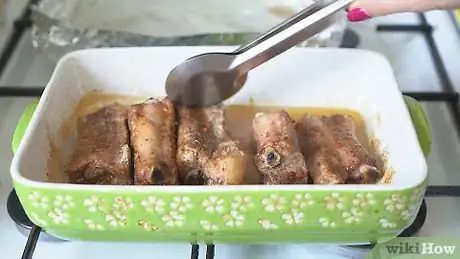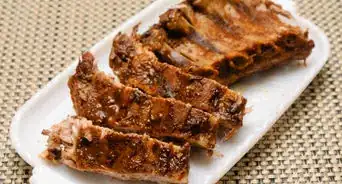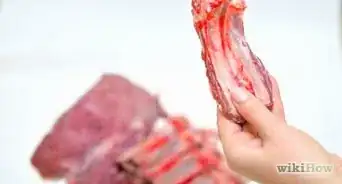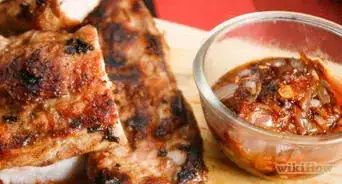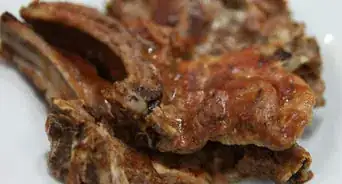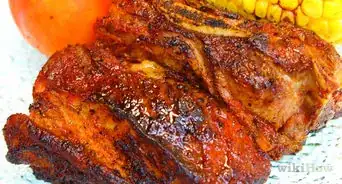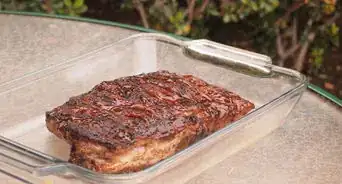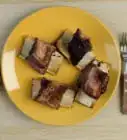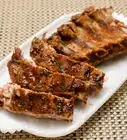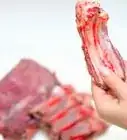This article was co-authored by wikiHow Staff. Our trained team of editors and researchers validate articles for accuracy and comprehensiveness. wikiHow's Content Management Team carefully monitors the work from our editorial staff to ensure that each article is backed by trusted research and meets our high quality standards.
There are 7 references cited in this article, which can be found at the bottom of the page.
The wikiHow Video Team also followed the article's instructions and verified that they work.
This article has been viewed 75,196 times.
Learn more...
When done correctly, the meat from slow-cooked pork ribs practically falls off the bone. As long as you have a few hours to dedicate to cooking the pork, making slow-cooked ribs is actually very simple and can be achieved multiple ways. Simply start by seasoning the pork with salt and pepper or a special dry rub. Then, choose between roasting the ribs in the oven, cooking them in a crockpot, or putting them on the grill. Once cooked, serve the ribs as is or coat them with your favorite barbecue.
Ingredients
- 2–2 1⁄2 lb (0.91–1.13 kg) of baby back pork ribs
- Dry rub, sauce, or salt and ground black pepper to taste
Yields 4 servings
- 2–2 1⁄2 lb (0.91–1.13 kg) of baby back pork ribs
- 1⁄2 cup (120 mL) of water or chicken broth (optional)
- Dry rub, sauce, or salt and ground black pepper to taste (optional)
Yields 4 servings
- 2–2 1⁄2 lb (0.91–1.13 kg) of baby back pork ribs
- Dry rub, sauce, or salt and ground black pepper to taste
Yields 4 servings
Sweet and Spicy Barbecue Sauce
- 1 US tbsp (15 mL) of olive oil
- 1/4 cup (37.5 g) of minced onion
- 1/2 tsp (1.05 g) ground cumin
- 1⁄2 cup (120 mL) of ketchup
- 1 US tbsp (15 mL) of hot chili sauce
- 2 tbsp (25 g) of light brown sugar
- 1 US tbsp (15 mL) of apple cider vinegar
- Salt and ground black pepper to taste
Yields approximately 1 cup (240 mL) of sauce
Pepper Barbecue Dry Rub
- 1/4 cup (28.75 g) of paprika
- 1 tbsp (5.4) of ground cumin
- 1 tbsp (12.5 g) of brown sugar, packed
- 1 tbsp (5.4 g) of chili powder
- 1 tbsp (5.4) of ground black pepper
- 1 1/2 tsp (3.15 g) cayenne pepper
- 1/4 tsp (0.5 g) of ground cloves
Yields 2/3 cup (61.1 g) of dry rub
Steps
Preparing the Ribs and Seasonings
-
1Trim unwanted fat from a rack of ribs and cut it into portions of 2-3 ribs each. Place a 2–2 1⁄2 lb (0.91–1.13 kg) rack of ribs on a cutting board. Use a sharp knife to trim away any unwanted fat or membranes. Then, carefully cut the rack of ribs into serving portions that are 2-3 ribs each.[1]
- If you do not want to trim and portion the ribs yourself, ask your local butcher if they would mind prepping the rack of ribs for you.
- Remember to wash your hands before and after handling the raw meat to avoid cross-contamination.
-
2Rub salt and pepper to taste on both sides of your ribs for a simple seasoning. Either place the ribs in a large bowl or leave them on your cutting board. Sprinkle salt and freshly ground black pepper on each side of the ribs. Use your fingers as needed to rub the seasoning into the meat to get it to stick.[2]
- Regardless of what cooking method you use, it is important to at least season the ribs with salt and pepper. Otherwise, your meat will taste bland after it is finished cooking.
- If you are planning to use a dry-rub to season your ribs, then incorporate the salt and pepper into the dry-rub instead.
Advertisement -
3Apply your favorite dry rub to the ribs for a more complex seasoning. Use your fingers to sprinkle the dry rub onto both sides of the ribs. Then, rub the seasoning into the meat and allow it to rest for 10 minutes before cooking it. Instead of using a store-bought dry rub, create your own!
- For example, create a pepper barbecue rub by mixing together 1/4 cup (28.75 g) of paprika, 1 tbsp (5.4) of ground cumin, 1 tbsp (12.5 g) of brown sugar, packed, 1 tbsp (5.4 g) of chili powder, 1 tbsp (5.4) of ground black pepper, 1 1/2 tsp (3.15 g) cayenne pepper, and 1/4 tsp (0.5 g) of ground cloves in a bowl.
- Create a simple spicy rub by mixing together 1 tbsp (5.4) of salt, ground black pepper, paprika, and chili powder.[3]
-
4Select your favorite barbecue sauce to use on your ribs after they are cooked. Pick sauces that are sweet, spicy, or tangy to complement the flavors of the pork. If you are using a dry rub on the ribs, then think about what sauce will complement the seasonings used in the dry rub. Either purchase your favorite sauce from your local grocery store or consider making a homemade sauce if you have the time.[4]
- For example, create a sweet and spicy barbecue sauce by placing 1 US tbsp (15 mL) of olive oil and 1/4 cup (37.5 g) of minced onion into a saucepan over a medium heat. Cook the onions until they are tender. Then, stir in 1/2 tsp (1.05 g) ground cumin, 1⁄2 cup (120 mL) of ketchup, 1 US tbsp (15 mL) of hot chili sauce, 2 tbsp (25 g) of light brown sugar, 1 US tbsp (15 mL) of apple cider vinegar, and salt and ground black pepper to taste. Allow this to cook for 2 minutes before removing it from the heat and setting it aside.
- Unless you are cooking the ribs in a slow cooker, refrain from applying the sauce until the ribs are fully cooked. Otherwise, the sauce will burn and ruin your ribs.
Making Oven-Roasted Ribs
-
1Preheat your oven to 225 °F (107 °C). Remove any baking sheets that you may have stored inside your oven. Then, place the oven rack on the middle rung before setting your oven to preheat.[5]
-
2Put your ribs, meat-side down, into a large roasting pan and cover it with foil. Arrange your seasoned ribs so that they are not overlapping and comfortably fit inside of a large roasting pan. Then, cover the top of the roasting pan with a piece of aluminum foil.[6]
- If you do not have a roasting pan large enough to support the number of ribs you have, split up the ribs into 2 smaller roasting pans or place them on a baking sheet with a lip.
-
3Bake the ribs in the oven at 225 °F (107 °C) for 3-4 hours. Place the covered roasting pan on the middle rung in the oven. Allow the ribs to slowly cook for 3-4 hours. When done, the meat will easily fall off the bone when prodded with a fork.[7]
- Check on the meat after letting it cook for 3 hours. Use a fork to pierce the meat on the ribs. If the meat falls off the bone, then it is finished cooking. If the meat is not tender, allow it to cook for the remaining hour.
-
4Take the roasting pan out of the oven and cover the ribs with sauce. Use potholders to carefully remove the roasting pan from the oven. Set the pan on your stovetop and discard the foil. Use a heat-resistant spoon to apply your choice in barbecue sauce to both sides of the ribs.[8]
- Use a pair of heat-resistant tongs to flip the ribs to make applying the sauce easier.
- Apply as much or as little of the sauce as you want on your ribs. Save any leftover sauce to dip the meat into later.
-
5Cook the uncovered ribs for another 20-30 minutes to caramelize the sauce. Use potholders to carefully place the uncovered roasting pan back into the oven. Allow the ribs to continue cooking for 20-30 minutes or until the sauce begins to bubble and caramelize.[9]
- Check on the ribs every 10 minutes to make sure that the sauce is not burning. If you notice that your sauce is beginning to burn or looks caramelized before the timer is up, remove the roasting pan from the oven.
-
6Remove the ribs from the oven and let them rest for 1-2 minutes before serving. Use potholders to take the roasting pan out of the oven. Place it on your stovetop or a hot plate, and let the ribs rest in its juices for 1-2 minutes. Then, serve the ribs alone or pair them with some of your favorite sides, like potato salad or macaroni salad.[10]
- Place any leftovers in a sealable container and store them for up to a week in the refrigerator.
Making Crockpot Ribs
-
1Pour 1⁄2 cup (120 mL) of water into your crockpot. While cooking, the ribs will secrete a lot of juice, but the water will keep them from sticking as the juices cook off. Just make sure that your crockpot can support the size of your ribs. Have a crockpot that can hold at least 6 US quarts (5,700 mL).[11]
- Consider seasoning the water with 1/2 of a sliced onion and 1 minced clove of garlic. If you chose not to use a dry rub beforehand, this will give the meat added flavor.
- Substitute the water with an equal amount of chicken broth to enhance the natural pork flavor.
- Use 2 cups (470 mL) of your chosen sauce to cook the ribs in. The juices from the ribs will water-down the sauce, but the seasonings from the sauce will greatly flavor the meat.
-
2Stand the ribs inside of the crockpot, so the meat is against the pot. Arrange your ribs so that they are vertical in your crockpot. Rest any thick, meaty ends along the bottom. If placed correctly, the meat-side of the rib will be against the pot and the bone-side will be facing inward.[12]
- If your ribs do not fit vertically in the crockpot, simply layer the portions within the pot, putting the thicker ones along the bottom.[13]
- If you poured a sauce into the pot, gently flip the ribs around in the sauce as you place them so that they are fully coated.
-
3Place the cover on the crockpot and cook on low for 7-8 hours. Leave the crockpot alone while it is cooking the ribs. Continuously removing the lid will increase the cooking time. Check on the ribs after 7 hours and poke the meat with a fork to see if it is cooked and tender. If not, then continue cooking it for the remaining hour.
- Alternatively, cook the ribs on a high setting for 4 hours. This is ideal for meals that were planned at the last minute.
-
4Remove the ribs from the crockpot and place them on a serving platter. Use a pair of heat-resistant tongs to take the ribs out of the crockpot. Be careful when doing this as the meat may fall off the bones very easily if jostled. Rest the ribs on a serving platter and enjoy![14]
- If you cooked your ribs in a sauce, spoon the thinned sauce onto the ribs or serve it on the side to dip the meat into.
- If you did not cook your ribs in a sauce, then take some time before serving the ribs to coat them in your choice of sauce. Make sure to coat both sides evenly.
- Remember to turn off and unplug your crockpot when you are finished using it. Allow it time to cool off before storing it away.
- Store any leftovers in a sealable container and keep them in the refrigerator for about a week.
Making Grilled Ribs
-
1Preheat your gas or charcoal grill to 325 °F (163 °C). Heat your gas or charcoal grill as you normally would. If needed, follow the manufacturer’s instructions for how to preheat your particular grill.[15]
- If you have a smoker box for your grill, consider prepping this with some wood chips to further flavor your meat. For example, apple wood chips greatly complement the natural flavors of the pork.
-
2Place your seasoned, portioned ribs bone-side down onto the grill. Use a pair of heat-resistant tongs to place the ribs on the grill rack. Do not place the ribs directly over the flame, as this will cook the meat quickly. Instead, only have half of your burners turned on and cook the ribs on the side of the grill rack where the burners are off. If your grill has a top rack, place the ribs there instead.[16]
-
3Cook the ribs over the indirect heat for 2-3 hours at 325 °F (163 °C). Close the lid on the grill and allow the ribs to cook. Check on the ribs every hour to make sure that they are not burning and are cooking properly. When done, the internal temperature of the meat will be about 190–200 °F (88–93 °C) and the meat will be tender.[17]
- Do not walk away from your grill for long periods, as this is considered a fire hazard.
-
4Coat the ribs in your selected sauce during the last 20 minutes of cooking. Use a sauce mop to apply the sauce to one side of the ribs, and then let it cook for 5 minutes to adhere. Flip the ribs over using a pair of heat-resistant tongs, and apply the sauce to the second side. Let the ribs cook for another 5 minutes, and repeat the process a second time to baste the ribs further.
- If you do not wish to apply a sauce to your ribs, then just continue cooking the ribs normally.
-
5Take the ribs off the grill and let them rest on a platter for 10 minutes. Use your heat-resistant tongs to take the ribs off the grill and place them onto a serving platter. Allow the ribs to rest in their juices for 10 minutes before cutting or serving them.[18]
- Apply additional sauce to the ribs before serving if desired or serve some of the sauce on the side to dip the meat into.
- Store any leftovers in a sealable container and keep them in the refrigerator for about a week.
Things You’ll Need
Oven-Roasted Ribs
- Cutting board
- Sharp knife
- Large roasting pan
- Aluminum foil
- Measuring cups and spoons
- Potholders
- Heat-resistant tongs
- Heat-resistant spoon
- Fork
Crock Pot Ribs
- Cutting board
- Sharp knife
- Crockpot
- Heat-resistant tongs
- Serving platter
- Measuring cups and spoons
- Fork
- Spoon
Grilled Ribs
- Cutting board
- Sharp knife
- Gas or charcoal grill
- Smoker box and wood chips (optional)
- Heat-resistant tongs
- Serving platter
- Sauce mop
References
- ↑ https://www.bhg.com/recipe/pork/asian-style-barbecue-ribs/
- ↑ https://www.inspiredtaste.net/7179/sweet-and-spicy-oven-baked-ribs/
- ↑ https://tasty.co/recipe/honey-garlic-slow-cooker-ribs
- ↑ https://www.inspiredtaste.net/7179/sweet-and-spicy-oven-baked-ribs/
- ↑ https://www.inspiredtaste.net/7179/sweet-and-spicy-oven-baked-ribs/
- ↑ https://www.geniuskitchen.com/recipe/low-slow-oven-baked-ribs-super-simple-303245
- ↑ https://www.inspiredtaste.net/7179/sweet-and-spicy-oven-baked-ribs/
- ↑ https://www.geniuskitchen.com/recipe/low-slow-oven-baked-ribs-super-simple-303245
- ↑ https://www.geniuskitchen.com/recipe/low-slow-oven-baked-ribs-super-simple-303245
- ↑ https://www.geniuskitchen.com/recipe/low-slow-oven-baked-ribs-super-simple-303245
- ↑ https://www.allrecipes.com/recipe/228498/slow-cooker-baby-back-ribs/
- ↑ https://tasty.co/recipe/honey-garlic-slow-cooker-ribs
- ↑ https://www.allrecipes.com/recipe/228498/slow-cooker-baby-back-ribs/
- ↑ https://tasty.co/recipe/honey-garlic-slow-cooker-ribs
- ↑ https://www.foodnetwork.com/recipes/grilled-slow-cooked-bbq-ribs-3743995
- ↑ https://www.cbsnews.com/news/for-perfect-ribs-go-low-and-slow/
- ↑ https://www.cbsnews.com/news/for-perfect-ribs-go-low-and-slow/
- ↑ https://www.cbsnews.com/news/for-perfect-ribs-go-low-and-slow/
About This Article
To slow cook ribs in the oven, start by placing them meat-side down in a large roasting pan. Then, cover the pan with foil, and cook the ribs at 225 degrees Fahrenheit for 3-4 hours, or until the meat easily falls off the bone. Next, take the ribs out of the oven, and cover them with a sauce, like barbecue sauce. Finally, cook the ribs in the oven for 20 more minutes to caramelize the sauce. To learn how to slow cook ribs on the grill or in a crockpot, scroll down!


